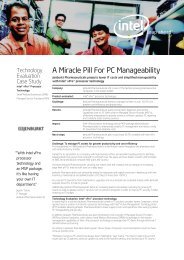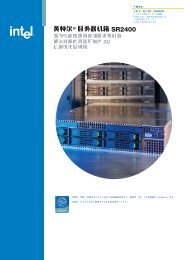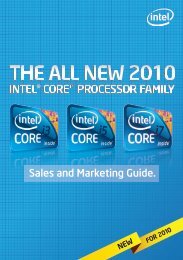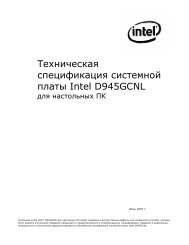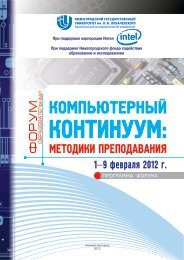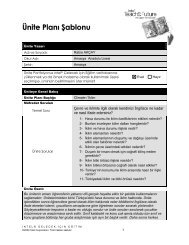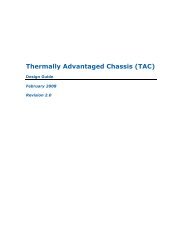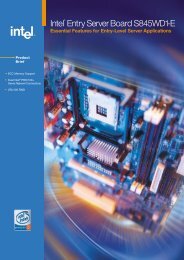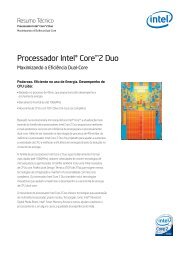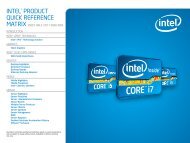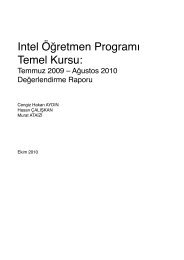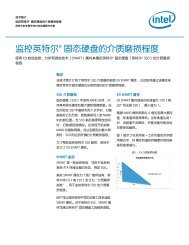Choosing the Right Client Computing Platform For Public Sector - Intel
Choosing the Right Client Computing Platform For Public Sector - Intel
Choosing the Right Client Computing Platform For Public Sector - Intel
You also want an ePaper? Increase the reach of your titles
YUMPU automatically turns print PDFs into web optimized ePapers that Google loves.
In this age of multi-core processors, <strong>the</strong> cache architecture of client<br />
CPUs are as important as cache size in ensuring better performance.<br />
The <strong>Intel</strong>® Advanced Smart Cache is a multi-core optimized cache<br />
that improves performance and efficiency by increasing <strong>the</strong><br />
probability that each execution core of a dual-core processor can<br />
access data from a higher-performance, more-efficient<br />
cache subsystem. To accomplish this, <strong>Intel</strong>® shares L2 cache<br />
between cores.<br />
Figure 5. Demands on cache are growing<br />
(for illustration purposes only)<br />
Data Intensive Usages /Apps<br />
Multi-tasking Usages<br />
64bits Apps and OSs<br />
By sharing L2 caches among each core, <strong>the</strong> <strong>Intel</strong>® Advanced Smart<br />
Cache also allows each core to dynamically use up to 100 percent<br />
of available L2 cache. When one core has minimal cache<br />
requirements, o<strong>the</strong>r cores can increase <strong>the</strong>ir percentage of L2 cache,<br />
reducing cache misses and increasing performance. Multi-Core<br />
Optimized Cache also enables obtaining data from cache at higher<br />
throughput rates.<br />
Figure 6. Cache Size Matters 4<br />
141<br />
144<br />
156<br />
WHy yOuR ORganizatiOn SHOuld CaRE aBOut<br />
SPECint, SPECfp, SPECrate are trademarks of Standard Performance Evaluation Corporation, see www.spec.org for more info. Using <strong>Intel</strong> C++ Compiler 9.1 for Windows*. Data collected Feb’07. Source: <strong>Intel</strong>. Configuration: Processors as listed above, <strong>Intel</strong>® DG965GF,<br />
<strong>Intel</strong> chipset software install file 8.0.1.1002, <strong>Intel</strong>® Graphics Media Accelerator 3000, Micron* 2x1GB DDR2 800 5-5-5-18, <strong>Intel</strong>® Matrix Storage Manager 6.0.0.1022 RAID-0 Ready, Maxtor* DiamondMax* 10 300GB NCQ Serial ATA 7200RPM, Windows* XP<br />
Professional Build 2600 SP2 NTFS, DirectX 9.0c. Performance tests and ratings are measured using specific computer systems and/or components and reflect <strong>the</strong> approximate performance of <strong>Intel</strong> products as measured by those tests. Any difference in system<br />
hardware or software design or configuration may affect actual performance. Buyers should consult o<strong>the</strong>r sources of information to evaluate <strong>the</strong> performance of systems or components <strong>the</strong>y are considering purchasing. <strong>For</strong> more information on performance tests and<br />
on <strong>the</strong> performance of <strong>Intel</strong> products, visit www.intel.com/performance.<br />
4 See Endnote for system configurations used for testing.<br />
Why your organization should care about:<br />
Cache architecture<br />
SYSmark* 2007 Preview<br />
Overall Scores<br />
200<br />
150<br />
100<br />
50<br />
E7200<br />
162<br />
180<br />
E7300 E8300 E8400 E8500<br />
High-K Core 2 Duo Processors<br />
3 MB Cache<br />
6 MB Cache<br />
8



